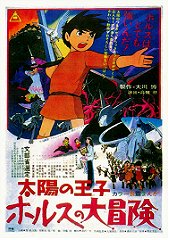For simplicity’s sake, I’m just going to refer to this title as Little Norse Prince in my review. If you’re interested, look up on IMDB or Wikipedia the numerous other titles it’s known by. And now onto our regularly scheduled programming…
Isao Takahata’s first feature film, Little Norse Prince, was also his first time working with Hayao Miyazaki, and it’s like a warm-up for both of their future films various obsessions and reoccurring motifs. It’s also just a solidly made film on its own merits, historical standing aside.
My only problems with the film were pretty basic: the English dub that I saw was in terrible shape and the vocal work was not the greatest. That’s it. Aside from these two problems, which I’m sure could only be improved upon if Netflix had access to a Japanese print that was cleaned up, Little Norse Prince is a solidly constructed film that tells its story with great economy, crafts unique and engaging characters, and has some moments of expressionistic and interesting animation. Ok, so maybe as a whole the animation is a little inconsistent, we’ll come back to that though.
Mostly known for its historical important, Little Norse Prince needs a reevaluation and reappraisal of its own strengths. Yes, it’s a test-run for everything that Studio Ghibli would build its empire upon, and, yes, later films would go on to better what was done here, but try watching Horus’ frantic fighting with wolves in the opening sequence and not becoming enthralled.
Fantastical creatures, conflicted hero(ines), philosophical and existential quandaries – everything that Takahata and Miyazaki do so well is represented here, and for the first time. There’s also the feeling that Takahata is trying valiantly to push animation towards more sophisticated and adult storytelling structures. That’s the great thing about Japanese animation, it plays to more audiences than just family friendly entertainment, and it pushes the art form beyond mere technicality. America has yet to catch up, but Laika’s releases and Wes Anderson’s one-time dip into the waters gave me hope that we might start seeing something more adventurous over here.
Earlier I said that the animation was inconsistent, and it is. Takahata fought hard to get his sequences perfected, but animation studio Toei was used to cracking out product in a few months. It’s clear when a battle was won or lost by Takahata in the animation, but some of this issue could also be the era. Japanese animation from the era had a rounded look, while Takahata was pushing it towards more angular and geometric shapes. Horus and Hilda appear more triangular and harsh than other characters, and it’s easy to see them and then look at the expressionistic and simplistic The Tale of the Princess Kaguya and imagine the bridge leading from one to the other.
Granted, a few of the lost battles resulted in clumsy inclusions like a talking animal sidekick and frequent musical numbers once we hit the village, but they didn’t hinder my enjoyment. There’s too much energy and seeds being planted for two of animation’s greatest artists, there’s simply too much that works and is good about Little Norse Prince. I mean, where else could cutesy animal sidekicks turn into fragments of a shell-shocked girl’s psyche locked in battle? No, it’s not perfect like his later films, but even here, Takahata was striving for and achieving something truly daring and mature in his work.
 Login
Login